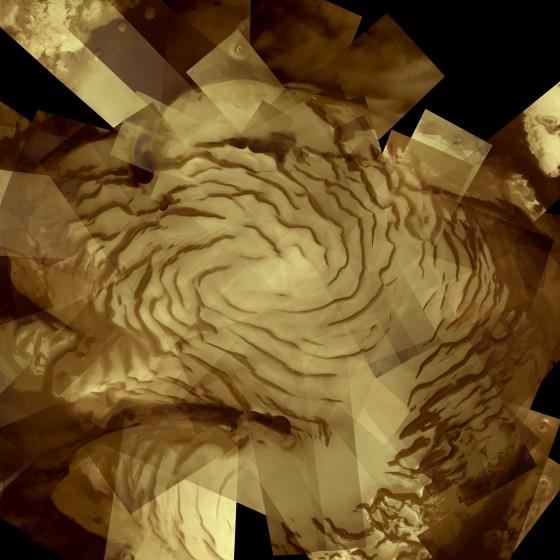MARS got a BANANAS Northern Polar Ice Cap.
Woah! What a dumb first line. Whatever. Double woah! Take a look at Mars’ northern polar ice cap. There are some seriously impressive natural forces taking place in this picture. Forces so majestic in scope that I cannot even begin to understand them. I’m just here for the free chicken and pictures!
io9:
You surely remember that image of Saturn’s 1,250 mile-wide polar hurricane shot by NASA’s Cassini spacecraft. Today European Space Agency released a similarly stunning image of Mars’s north polar ice cap on the 10th anniversary of the ESA’s Mars Express mission launched on 2 June 2003.
This glorious golden mosaic was made of 57 separate images taken by the orbiter’s High Resolution Stereo Camera throughout the entire mission. The images were taken when Mars Express was closest to Mars along its orbit, at about 300-500 km altitude. ESA explains what can be seen in this mesmerizing photo:
The ice cap has a diameter of about 1000 km and, thanks to the ground-penetrating radar on Mars Express, scientists know that layers of water-ice extend to a depth of around 2 km below the cap. The layers result from seasonal melting and deposition of ice mixed with dust. The water-ice is covered by a thin layer of carbon dioxide ice that is a few centimetres to a few tens of centimetres thick. During the warmer summer months, most of the carbon dioxide ice turns directly into vapour and escapes into the atmosphere, leaving behind the water-ice layers. Each winter the ice cap grows by adding 1.5–2 m of dry ice, with seasonal ice deposits extending as far south as 45º.
Strong prevailing winds at the poles are thought to be responsible for shaping the spiral troughs, which seem to pinwheel around the ice cap. Biting into the spirals at the lower left in this image is a 318 km-long, 2 km-deep chasm called Chasma Boreale. The plunging canyon formed before the spiral troughs, growing deeper as new ice deposits built up around it. Close-up views show that the floor of Chasma Boreale is covered by dark sand dunes sprinkled with a coating of white frost.





